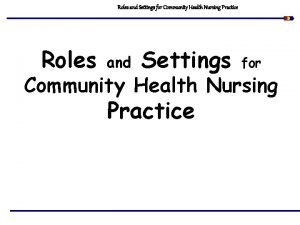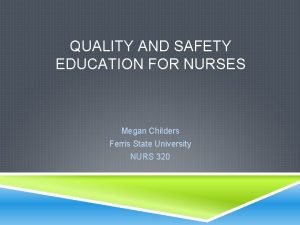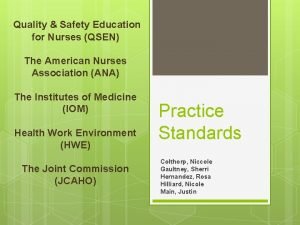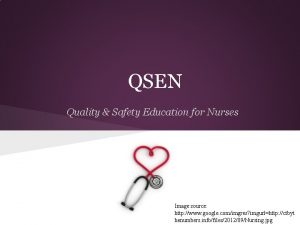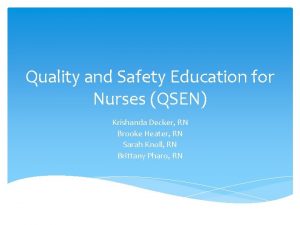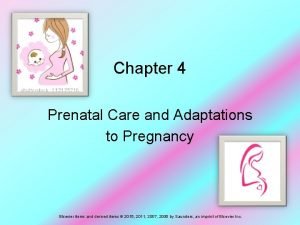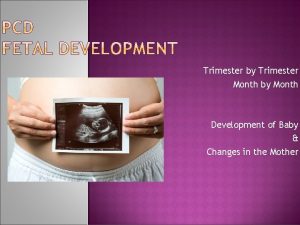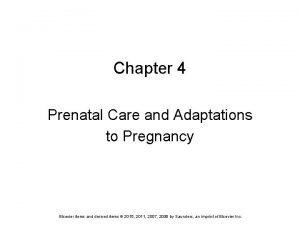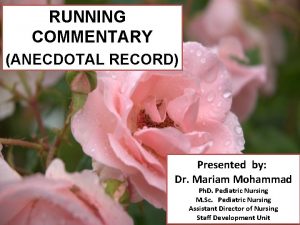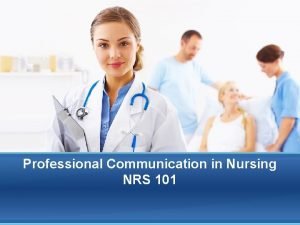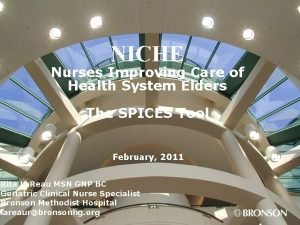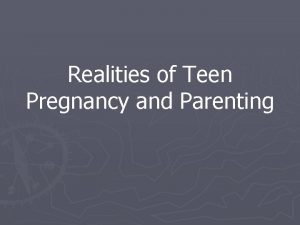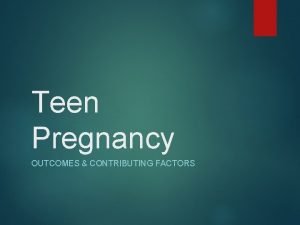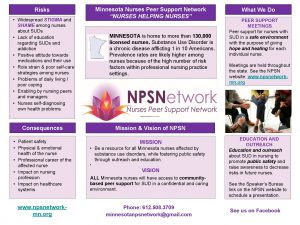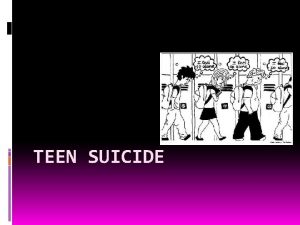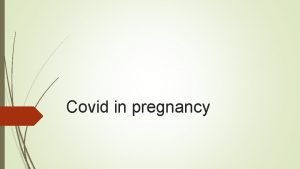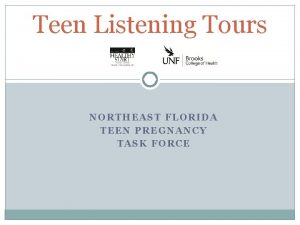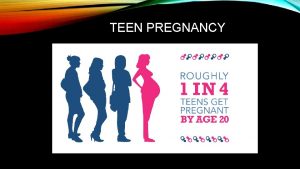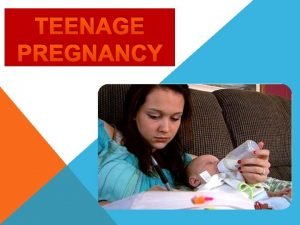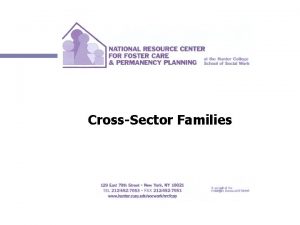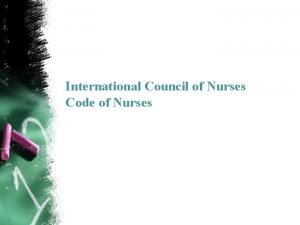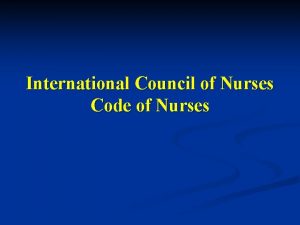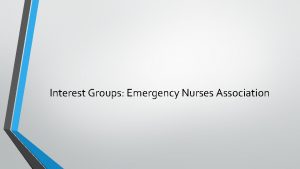Teen Pregnancy and Teen Families Role of Nurses


































- Slides: 34

Teen Pregnancy and Teen Families: Role of Nurses By Nataliya Haliyash, MD, Ph. D, MSN Ternopil State Medical University Institute of Nursing

Lecture objectives Upon completing the lecture students will be able: • to understand the impact of teen childbearing on the families and communities; • to be able to recognize the special needs of pregnant and parenting teens in order to improve their health and life outcomes and those of their children; • to be able to provide services for teens that are already pregnant and/or have become parents. Mosby items and derived items © 2005, 2001 by Mosby, Inc.

The impact of teen childbearing • The teenage pregnancy rate declined : – in 1991 – 117 per 1, 000 – in 2004 – 72 per 1, 000. • Similarly, the birth rate decreased by 30. 5 percent : – in 1991 – 61. 8 births per 1, 000 females ages 15 -19 – in 2005 – 40. 4 births per 1, 000, the lowest rate in six decades. • However, preliminary data from the Centers for Disease Control and Prevention (CDC) on births in 2006 indicate that the overall birth rate for teenage girls rose 3 percent: – in 2006 – 41. 9 births per 1, 000 females ages 15 -19. – in 2009 – 39. 1 births per 1, 000 females ages 15 -19. Mosby items and derived items © 2005, 2001 by Mosby, Inc.

The impact of teen childbearing • U. S. leads in number of teen pregnancies when compared Canada and Great Britain (Porter & Holness, 2011). • In 2004, the cost to federal, state and local taxpayers related to teenage childbirth was approximately $9. 1 billion dollars. (The National Campaign to Prevent Teen and Unplanned Pregnancy, 2010). • A repeat pregnancy is noted to occur 500 times more often with a teen mother. (Porter & Holness, 2011). Mosby items and derived items © 2005, 2001 by Mosby, Inc.

The prevalence of adolescent pregnancy in the world • About 16 million adolescent girls aged 15 -19 give birth each year, roughly 11% of all births worldwide: – Almost 95% of these births occur in developing countries. – They range from about 2% in China to 18% in Latin America and the Caribbean. – Adolescent birth rates in the less developed countries are more than twice as high compared to rates in more developed countries and these range from less than 1% per year in places like Japan and the Republic of Korea, to over 20% per year in the Democratic Republic of Congo, Liberia and Niger. Mosby items and derived items © 2005, 2001 by Mosby, Inc.

Childbearing to mothers under 15, is a problem in certain countries • An analysis of survey data from 51 developing countries from the mid-1990 s to the early 2000 s showed that almost 10% of girls were mothers by age 16, with the highest rates in sub-Saharan Africa and South-Central and South-Eastern Asia. • Because the health risks of early childbearing appear to be magnified for the youngest mothers, these very early births are a major concern. Mosby items and derived items © 2005, 2001 by Mosby, Inc.

However, while there is a definite need for effective efforts that focus on preventing teen pregnancy in order to halt the recent increase in the teen birth rate, we can not ignore the fact that teens are still becoming parents and that these teen parents need supportive programs and services in order to reduce the risks for teen parents and their children. Mosby items and derived items © 2005, 2001 by Mosby, Inc.

The needs of pregnant and parenting teens • Research shows that teenage pregnancy is associated with: – medical-related risks for the teen mother and infant – and developmental risks for the growing infant. Mosby items and derived items © 2005, 2001 by Mosby, Inc.

In what context do adolescents become pregnant? • In developing countries, about 90% of births to adolescents occur within marriage • The proportion is close to 100% in – Western Asia/Northern Africa, – Central Asia, – and South-Central and South-Eastern Asia, • while between 70 -80% in South America and in sub-Saharan Africa Mosby items and derived items © 2005, 2001 by Mosby, Inc.

In what context do adolescents become pregnant? (cont. ) • About 75% of adolescent pregnancies are intended, ranging from 42% in Colombia to 93% in Egypt. • A small but significant percentage of adolescent pregnancies result from nonconsensual sex. – Recent studies of coerced first sex report rates between 10% and 45% of girls who first had sex before age 15. Mosby items and derived items © 2005, 2001 by Mosby, Inc.

Risk factors for teen mothers and their babies • A study in Latin America found that maternal death rates for adolescents under 16 are 4 times greater than for women in their 20 s. • Increased incidence of: – – – – – Low birth weight Infection and neonatal death SIDS Well being of mother threatened with medical and social problems Social issues Low socioeconomic status Low education for the mother Substance abuse Single parent families Possibility for substandard prenatal care (Porter & Holness, 2011) Mosby items and derived items © 2005, 2001 by Mosby, Inc.

Risk factors for a child of a teen mother – Health and chronic illness problems – Increased chance of becoming a teen parent (Herrman, 2010) (as cited in Hoffman, 2006) – Greater risk of homelessness, incarceration, dropping out of high school – Increased risk of being abused (Herrman, 2010) (as cited in Healthy Teen Network, 2007). Mosby items and derived items © 2005, 2001 by Mosby, Inc.

Societal and socioeconomic impact of teen pregnancy • Studies have shown that delaying adolescent births could significantly lower population growth rates, potentially generating broad economic and social benefits. • Numerous studies have shown an association between adolescent pregnancy, and negative social and economic effects on both the mother and her child. However, recent reviews have found the evidence inconclusive about whether adolescent pregnancy is the cause or consequence of adverse socioeconomic factors. Mosby items and derived items © 2005, 2001 by Mosby, Inc.

INTERVENTIONS – – – – – Theories/Teen pregnancy research Social-Cognitive-Ecological Theories Developmental Theories Resilience Theory (Porter & Holness, 2011) Home visitation School-based programs Community-based programs Contraception Abstinence Mosby items and derived items © 2005, 2001 by Mosby, Inc.

INTERVENTIONS (cont. ) • How can adolescent pregnancy be made safer? • Mothers and babies need care in pregnancy, for childbirth and after birth. It must be delivered as a continuum of care that starts in the household and community and extends into the healthcare system, including care for complications. Mosby items and derived items © 2005, 2001 by Mosby, Inc.

Individual, Family, and Community Care • Programs should emphasize: – Improving the involvement of boys and men and the community at large, and including “mothers-in-law” in societies where they are the main decision-makers both at household and community level, would ensure their support and acceptance in utilization of services. – Ensuring good pregnancy outcomes start with homebased care practices that support the mother and her newborn before, during, and after the pregnancy. – Adolescent mothers should be provided with life skills (including vocational training) and sexuality education to increase their autonomy, mobility, self-esteem, and decision-making abilities. Mosby items and derived items © 2005, 2001 by Mosby, Inc.

Individual, Family, and Community Care (cont. ) – Knowledge about pregnancy complications and recognizing the signs of complications should be widely disseminated to pregnant adolescents, their families and the community at large. – Programs should be put in place to retain adolescent girls in school. – Because adolescents are relatively more susceptible to violence from intimate partners than are older women, it is important to implement programs to empower adolescents to deal with domestic violence. – Programs should also find ways to reduce the cost of pregnancy care for adolescents, who tend to have fewer financial resources. Mosby items and derived items © 2005, 2001 by Mosby, Inc.

Types of Community Programs for Pregnant Teens School-based program – Valley High Teen Mom Program Faith-based program – LDS Family Services – Catholic Community Services – Additional Services available Community-based program – Utah Parents as Teachers – Teen Mother program Mosby items and derived items © 2005, 2001 by Mosby, Inc.

Resilience-Recoil-Rebound Theory of Teen Pregnancy Prevention • Resilience – The ability to "bounce back" when faced with a challenging experience in life (Porter & Holness, 2011) (as cited in American Psychological Association [APA], 2011; Luthar & Cicchetti, 2000). – Reflected in coping skills when faced with pregnancy • Recoil-Rebound – Refers to recovery when faced with a setback in life with optimism and hope for the future • Strong support systems are needed to reinforce resilience in teen mothers at risk for repeat pregnancy – – – Family Peer groups School Church Community Mosby items and derived items © 2005, 2001 by Mosby, Inc.

Home Visitation Programs – Begin as early in the pregnancy as possible – Continue after birth of baby and through two years of age – Follow Olds Model – Establish a trust relationship – Visit weekly for the first month – Every other week until delivery (Robert Wood Johnson Foundation, 2008) – After delivery, resume home visits at eight weeks, every other week through the child's second birthday – Certified Nurse Midwives visit for the first eight weeks Mosby items and derived items © 2005, 2001 by Mosby, Inc.

Outpatient and Clinical Care • The content of such clinical and outreach interventions should be the same for adolescent mothers as for other women: – It is important to provide adolescents with an early start to antenatal care and to options for continuing or terminating pregnancy, particularly because adolescents tend to delay seeking abortion, resort to the use of less skilled providers, use more dangerous methods, and delay seeking care for complications. – They are, therefore, more likely to suffer serious complications and even death. – Since adolescents are especially susceptible to anemia in pregnancy, it is important for programs to make a special effort to diagnose and treat for anemia. Mosby items and derived items © 2005, 2001 by Mosby, Inc.

Outpatient and Clinical Care (cont. ) • Adverse outcomes such as low birth weight can be reduced by improving the nutritional status of adolescents before pregnancy and preventing sexually transmitted infections before and during pregnancy. • Pregnant adolescents especially first time mothers are particularly susceptible to malaria, a major factor in maternal deaths in some countries. Priority should be given in treatment and management of malaria in pregnancy. • Special attention should be given to adolescents under 16 during obstetric care because they and their infants are at especially high risk of complications and death. Mosby items and derived items © 2005, 2001 by Mosby, Inc.

Outpatient and Clinical Care (cont. ) • Discussion of the “Plan for Birth and Complications, ” including the place of birth, availability of transportation, companion of choice, and costs involved, is essential, particularly for adolescents in light of the higher incidence of complications both for the mother and her newborn. • Health workers should prioritize adolescents’ access to services to prevent mother-to-child transmission of HIV, given the high concentration of infection rates in young women. • It is important that adolescent mothers be counseled and provided with post partum family planning methods of their choice to avoid future adolescent pregnancy. Mosby items and derived items © 2005, 2001 by Mosby, Inc.

Health Systems Features • In addition to the special interventions that would enhance the continuum of care for adolescents and their babies, countries can incorporate features into their health systems that can improve adolescents’ access to quality care including that for contraception and, ultimately, health outcomes. • A crucial area of focus is in human resources, where evidence shows the importance of developing health worker competencies in dealing with the special information and psychosocial needs of adolescent mothers. • A more conducive legal and policy environment that enhances access to care for adolescents including contraceptive services is needed. Mosby items and derived items © 2005, 2001 by Mosby, Inc.

Planned Parenthood Programs • Planned Parenthood believes that it is important to help teens delay having sexual intercourse, • but it also believes that policy makers must accept the fact that teens engage in sexual behavior, • and they must initiate and provide funding for various programs and interventions that will facilitate responsible sexual behavior. Mosby items and derived items © 2005, 2001 by Mosby, Inc.

Sex Education Can Help Prevent Teenage Pregnancy • Sex education programs that are balanced and realistic: – encourage students to postpone sex until they are older, – and promote safer-sex practices among those who choose to be sexually active, • have been proven effective at delaying first intercourse and increasing use of contraception among sexually active youth. • These programs have not been shown to initiate early sexual activity or to increase levels of sexual activity or numbers of sexual partners among sexually active youth (Kirby, 2007; Kohler et al. , 2008). Mosby items and derived items © 2005, 2001 by Mosby, Inc.

Sex Education Can Help Prevent Teenage Pregnancy (cont. ) • Sex education that is responsible and medically accurate, begins in kindergarten, and continues in an age-appropriate manner through the 12 th grade, is necessary given the early ages at which young people are initiating intercourse — 6. 2 percent of students nationwide report having sex before the age of 13, 43. 8 percent by grade 10, and 63. 1 percent by grade 12 (CDC, 2012). • In fact, the most successful programs aimed at reducing teenage pregnancy are those targeting younger adolescents who are not yet sexually experienced (Frost & Forrest, 1995). Mosby items and derived items © 2005, 2001 by Mosby, Inc.

Sex Education is a Success in Other Developed Nations • The Netherlands, where sex education begins in preschool and is integrated into all levels and subjects of schooling, boasts one of the lowest teen birthrates in the world — 5. 3 per 1, 000 women aged 15– 19 — a rate six and a half times lower than that of the U. S. (Berne & Huberman, 1999; United Nations, 2011). • In Germany, where sex education is comprehensive and targeted to meet the reading and developmental needs of the students, the teenage birthrate is three and a half times lower than that of the U. S. ; its teenage abortion rate is about five times lower. Mosby items and derived items © 2005, 2001 by Mosby, Inc.

The Media Has an Important Role in Pregnancy Prevention • Another source of teen information about sex is the media: – In the U. S. , one in three television programs contains a scene devoting primary emphasis to sexual behavior, and one in 10 contains a scene in which intercourse is depicted or strongly implied, yet sexual precautions and the consequences of sexual behavior are rarely depicted (Kunkel et al. , 2005). – Research clearly shows that television portrayals contribute to sexual socialization — watching programs high in sexual content has been correlated with the early initiation of adolescent sexual intercourse (Collins et al. , 2004). Mosby items and derived items © 2005, 2001 by Mosby, Inc.

The Media Has an Important Role in Pregnancy Prevention (cont. ) • The U. S. needs a long-term teenage pregnancy prevention media campaign that addresses the consequences of sexual behavior. • At present, most major networks do not air commercials or public information campaigns about sexual health. • Developed countries such as the Netherlands, Germany, and France, in which teenage birthrates are three to six and a half times lower than that of the U. S. , promote healthy, lowerrisk sexual behavior through national media campaigns that have a high degree of influence with young women and men (Berne & Huberman, 1999). Mosby items and derived items © 2005, 2001 by Mosby, Inc.

Conclusion • Making pregnancy safer for the youngest mothers and their babies is a priority for countries as they strive to meet targets for improving basic health care. • Maternal and newborn health programs have a clear role in better serving the needs of the youngest mothers. Mosby items and derived items © 2005, 2001 by Mosby, Inc.

References American Psychological Association. (2011). The road to resilience. Washington DC: Author. Retrieved from http: //www. apa. org/helpcenter/road-resilience. aspx Herrman, J. W. (2010). Assessing the teen parent family. The role for nurses. Nursing for Women's Health, 114(3), 214 -221. doi: 10. 111/j. 1751486 X. 2010. 01542 x Luthar, S. S. , & Cicchetti, D. (2000). The construct of resilience: Implications for interventions and social policies. Development & Psychopathology, 12(4), 357 -885. Porter, L. S. & Holness, N. A. (2011). Breaking the repeat teen pregnancy cycle. How nurses can nurture resilience in atrisk teens. Nursing for Women's Health, 15(5), 370 -381. doi: 10. 1111/j. 1751 -486 X. 2011. 01661. x Robert Wood Johnson Foundation. (2008). A closer look at the olds model. Retrieved from http: //www. rwjf. org/pr/product. jsp? id=51653 Mosby items and derived items © 2005, 2001 by Mosby, Inc.

Mosby items and derived items © 2005, 2001 by Mosby, Inc.

Thank you for attention! Q&A?
 Fallon sherrock smoking
Fallon sherrock smoking Implantation spotting
Implantation spotting Big families vs small families
Big families vs small families Conceptual skills examples
Conceptual skills examples Nurses role in therapeutic community
Nurses role in therapeutic community Web role in azure
Web role in azure Interaktionistisches rollenmodell
Interaktionistisches rollenmodell Statuses and their related roles determine
Statuses and their related roles determine Pregnancy and infant cohort monitoring and evaluation
Pregnancy and infant cohort monitoring and evaluation Megan childers
Megan childers Www.tamilnadunursingcouncil.com
Www.tamilnadunursingcouncil.com Quality and safety education for nurses
Quality and safety education for nurses Quality and safety education for nurses
Quality and safety education for nurses Safe staffing ratios: benefiting nurses and patients
Safe staffing ratios: benefiting nurses and patients Qsen ksa
Qsen ksa Comparison of logic families table
Comparison of logic families table Compare and contrast the bach and marsalis families
Compare and contrast the bach and marsalis families Compare and contrast the bach and marsalis families
Compare and contrast the bach and marsalis families Marriages and families 8th edition
Marriages and families 8th edition Marriages and families changes choices and constraints
Marriages and families changes choices and constraints Name that
Name that Budd-chiari syndrome triad
Budd-chiari syndrome triad Prenatal care and adaptations to pregnancy
Prenatal care and adaptations to pregnancy Chapter 20 reproduction and pregnancy
Chapter 20 reproduction and pregnancy Chapter 13 anatomy and physiology of pregnancy
Chapter 13 anatomy and physiology of pregnancy Pregnancy and fetal development brainpop answers
Pregnancy and fetal development brainpop answers Nifas icd 10
Nifas icd 10 With whom did shilpi and her husband discuss pregnancy?
With whom did shilpi and her husband discuss pregnancy? Chapter 4 prenatal care and adaptations to pregnancy
Chapter 4 prenatal care and adaptations to pregnancy Early pregnancy symptoms cramps
Early pregnancy symptoms cramps Betty smith williams
Betty smith williams Great 100 nurses nomination examples
Great 100 nurses nomination examples Running commentary examples
Running commentary examples Nursing narrative note
Nursing narrative note Bronson intranet
Bronson intranet



